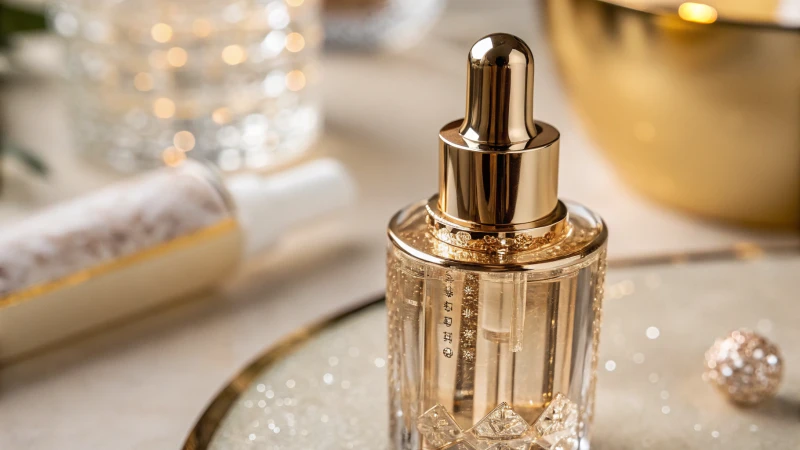
Have you ever noticed how a shiny metallic dropper cap can elevate a skincare product? It’s no accident.
Metallic finishes on droppers are key in luxury branding, instantly signaling quality and exclusivity. These finishes not only enhance the product’s aesthetic appeal but also embody brand values, crafting a seamless consumer experience that aligns with luxury standards.
I remember the first time I held a high-end serum bottle with a metallic dropper; it felt like I was cradling a piece of art. The shimmer of the metal immediately told me I was holding something special—something that was crafted with care and precision. This isn’t just about looks; it’s about conveying a message. In luxury branding, every detail counts. Those gleaming metallic finishes aren’t just pretty faces—they’re storytellers, whispering tales of quality and exclusivity.
But there’s more than meets the eye. Behind the scenes, creating those perfect metallic finishes involves a dance of technical precision and creative artistry. It’s about balancing the intricate production processes with sustainable practices, especially in today’s eco-conscious market. Imagine trying to maintain that luxurious allure while ensuring the environmental footprint remains gentle—a challenge, indeed, but one that can set your brand apart. With the right approach, metallic finishes can become more than just a visual treat; they can be the very heart of your brand’s identity.
Metallic droppers increase product appeal in luxury branding.True
Metallic finishes signal quality and exclusivity, enhancing product appeal.
Sustainability is unaffected by metallic finishes on droppers.False
Metallic finishes pose sustainability challenges, affecting environmental impact.
What Are the Key Benefits of Using Metallic Finishes in Packaging?
Remember the first time something shiny caught your eye and you just had to have it? That’s the magic metallic finishes bring to packaging.
Metallic finishes in packaging elevate visual appeal, signify luxury, and boost durability. They help brands stand out with unique aesthetics and can be eco-friendly by using recyclable materials like aluminum.
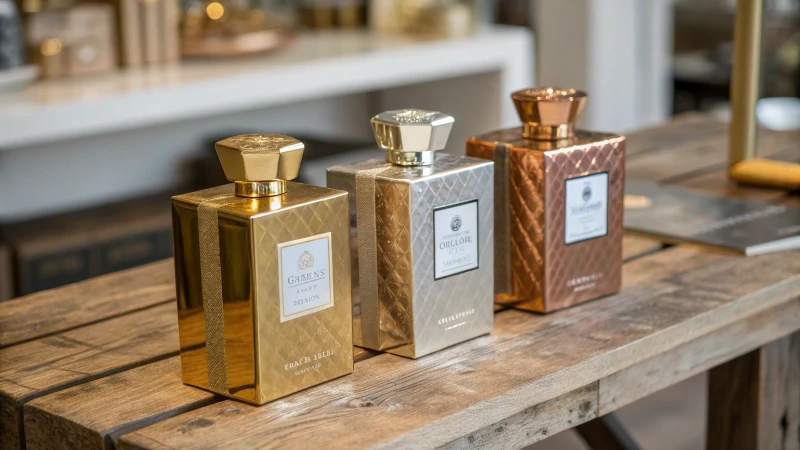
Enhanced Aesthetic Appeal and Luxury
Every time I walk into a store, it’s those gleaming packages that grab my attention first. There’s something about a metallic finish that whispers luxury and sophistication. I once helped a friend choose a gift, and we both gravitated toward this beautifully packaged skincare set with a gold finish. It wasn’t just about the product inside; it was the promise of elegance that came with it. That’s the power of a metallic sheen—it transforms ordinary into extraordinary and can make your product leap off the shelf. Brand positioning1 becomes a breeze when your packaging is this eye-catching.
Table: Common Metallic Finish Options
| Finish Type | Typical Uses |
|---|---|
| Gold | High-end skincare, perfumes |
| Silver | Electronics packaging |
| Rose Gold | Modern cosmetics |
Brand Differentiation
Standing out in a sea of sameness is crucial. I remember a time at a trade show when I stumbled upon a booth that seemed to glow differently from others. It was the metallic packaging that set them apart, each one telling its own story. These finishes can evoke emotions and build connections, reinforcing the brand’s narrative2 like nothing else.
Improved Durability
Let’s not forget practicality—metallic finishes aren’t just pretty; they’re tough too. A while back, during a particularly rainy season, I noticed how some packages retained their shine despite the harsh weather. Materials like aluminum are not only durable but also resist corrosion, ensuring that products maintain their premium look, come rain or shine.
Sustainability Advantages
Sustainability is more than a buzzword—it’s a movement. I often find myself weighing options for eco-friendliness, knowing full well that metals like aluminum can be recycled. This makes metallic finishes a perfect ally for eco-conscious consumers3, aligning beauty with responsibility.
Production Complexities and Solutions
It’s not all glitter, though. The production of metallic finishes can be complex, requiring precision techniques like anodizing or brushing. But innovation is on our side; companies are exploring 3D printing to streamline processes and offer more customizable solutions4. Collaborating with suppliers who leverage advanced tech can lead to better quality control and cost efficiency.
Industry Tip: I’ve found that working with suppliers who are ahead of the tech curve can make all the difference in quality and cost-effectiveness.
Embracing metallic finishes isn’t just about adding shine; it’s about enhancing appeal, functionality, and sustainability. It’s about creating packaging that tells a story and resonates with consumers, positioning your brand as a leader in its market segment.
Metallic finishes improve packaging durability.True
Metallic materials like aluminum resist corrosion, enhancing durability.
All metallic finishes are non-recyclable.False
Metals such as aluminum are recyclable, supporting sustainability.
How Do Metallic Finishes Influence Production Processes?
Ever wondered how that sleek, metallic finish on your favorite product impacts its production journey?
Metallic finishes add layers of complexity to production by influencing material choices, escalating costs, and necessitating precise application techniques like anodizing or PVD coating. These factors play a crucial role in determining the quality and timeline of manufacturing.
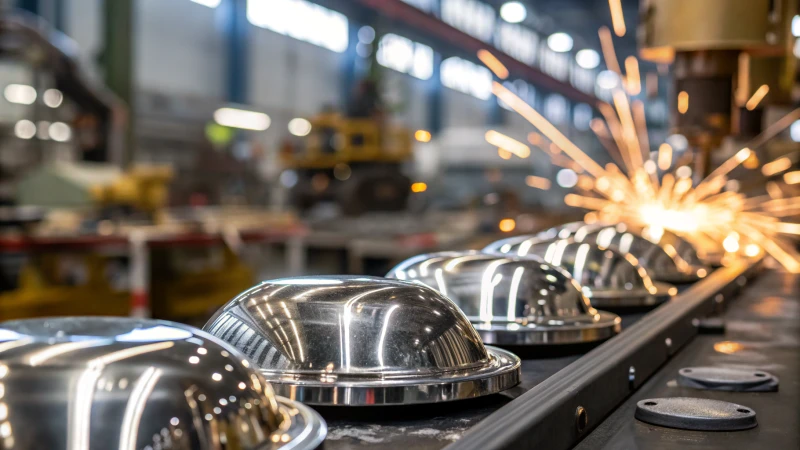
The Role of Metallic Finishes in Material Selection
I remember the first time I opted for a metallic finish on a project—it was both exciting and nerve-wracking. Choosing the right material became a crucial decision. Aluminum often tops the list for its lightweight nature, but I had to ensure it wouldn’t warp during the anodizing5 process.
Challenges in Material Processing
The material choice significantly shaped my production workflow. Metals prone to corrosion required protective coatings, adding more steps—and time—to my schedule. Processing metals with poor thermal conductivity? That was another beast, leading to surface treatment inconsistencies that had to be ironed out.
Techniques Used in Applying Metallic Finishes
Applying these finishes isn’t just about aesthetics; it involves a careful dance of science and art. Techniques like Physical Vapor Deposition6 (PVD), electroplating, and brushing each have their own quirks. Controlling temperature and pressure precisely was something I learned the hard way—trial and error, anyone?
| Technique | Benefits | Challenges |
|---|---|---|
| Anodizing | Enhanced durability and corrosion resistance | Requires precise control of voltage |
| PVD Coating | Superior finish with minimal material waste | High initial setup cost |
| Electroplating | Cost-effective for bulk production | Potential for uneven coating |
Cost Implications and Quality Control
Every time I implement a metallic finish, I’m reminded of the cost implications—it’s not just about the equipment but also the skilled labor needed. I’ve found that thorough quality control is essential to meet aesthetic and functional standards7. Regular inspections save me from headaches like peeling finishes or unexpected discolorations.
- Cost Factors: Investing in high-end machinery and skilled labor has certainly increased my overheads.
- Quality Assurance: I’ve learned to prioritize regular inspections and tests to prevent defects.
Impact on Production Timelines
I’ve come to accept that metallic finishes will extend production cycles—polishing and coating are extra steps that require patience. Delays are almost inevitable if quality checks reveal imperfections needing rework, which can throw delivery schedules off track.
Overall, while metallic finishes undeniably boost product appeal and marketability, they demand a level of planning and execution that’s become second nature to me.
Aluminum warps during anodizing without careful management.True
Aluminum's lightweight nature makes it prone to warping if not managed well during anodizing.
Electroplating is the most expensive metallic finish technique.False
Electroplating is cost-effective for bulk production, unlike PVD coating, which has high setup costs.
How Do Metallic Finishes Enhance Sustainability?
Ever wondered how those shiny, metallic finishes on your favorite products could be more than just eye candy?
Metallic finishes contribute to sustainability by being durable and recyclable, especially when crafted from metals like aluminum and stainless steel. These materials not only reduce waste but also support a circular economy through effective recycling initiatives.
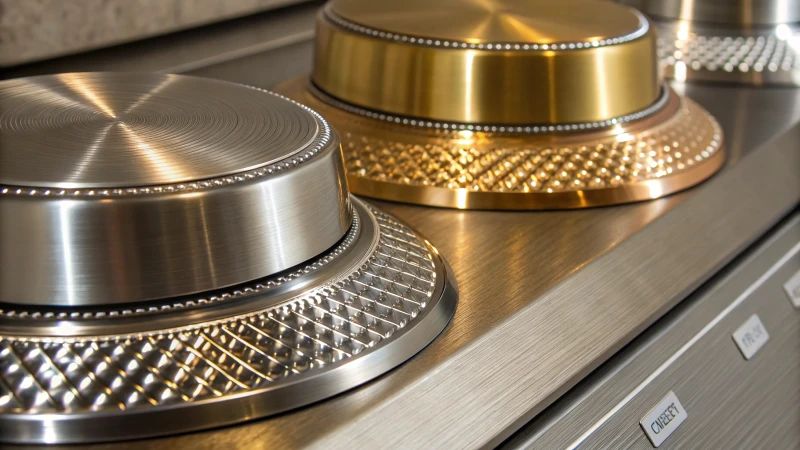
A Personal Dive into Durability and Longevity
You know, growing up, I always admired my grandfather’s old toolbox. It was filled with tools that had metallic finishes, each one gleaming as if saying, "I’m built to last." It struck me how these tools, with their durable finishes, stood the test of time, much like how metallic finishes in products today enhance longevity. By making products last longer, these finishes help cut down on the need for replacements, which is a win for reducing waste. It aligns perfectly with sustainable manufacturing practices8 that prioritize materials meant to endure.
Recyclability: The Heart of Sustainability
Back when I first learned about recycling, it felt like uncovering a secret superpower. Imagine metals like aluminum and stainless steel as the superheroes of sustainability because they’re highly recyclable. This trait is vital in supporting a circular economy—a concept that feels as important as it sounds. Recycling aluminum, for example, saves up to 95% of the energy needed to make new aluminum from scratch. That’s a massive energy saving and it highlights the critical role of metal recycling9 in sustainable development.
| Metal Type | Energy Savings from Recycling |
|---|---|
| Aluminum | Up to 95% |
| Steel | Around 60% |
Overcoming Production Challenges
Of course, it’s not all sunshine and rainbows. Despite their perks, creating metallic finishes can be quite challenging. I’ve heard stories from friends in manufacturing about how energy-intensive these processes can be, often leading to significant carbon emissions. However, the silver lining is that technology is evolving. Some manufacturers are now harnessing renewable energy sources to power their production facilities, reducing environmental impact significantly.
Innovating for Eco-Friendly Finishes
It’s amazing how innovation can lead to eco-friendliness. Techniques like powder coating are a game-changer—they offer a solvent-free alternative that cuts down on VOC emissions. It’s like giving our planet a bit of a breather! Moreover, advancements in eco-friendly surface treatments10 are enabling us to achieve those desired finishes without sacrificing environmental integrity.
Riding the Wave of Consumer Perception and Trends
There’s something exciting about seeing more people leaning towards sustainable products. It’s a trend that’s hard to ignore. Consumers today have this amazing ability to sway market dynamics by choosing brands that value environmental responsibility. For brands, having metallic finishes that marry aesthetics with sustainability can offer a unique competitive edge. This is particularly true in markets dominated by eco-conscious consumers11.
By focusing on metallic finishes that are sustainably produced, companies can tap into this emerging market segment, reinforcing brand values and commitment to sustainability. It’s an inspiring journey that not only benefits businesses but also champions the well-being of our planet.
Metallic finishes increase product longevity.True
Durable metallic finishes extend product life, reducing waste.
Recycling steel saves 95% energy compared to new production.False
Recycling steel saves around 60% energy, not 95% like aluminum.
How Can Metallic Finishes Be Used for Brand Differentiation?
Imagine walking into a store and immediately being drawn to a product, not just because of what’s inside, but because of its gleaming metallic packaging. That’s the power of metallic finishes in branding.
Metallic finishes differentiate brands by exuding luxury, distinctiveness, and environmental consciousness. They boost visual allure and convey brand values, making products unforgettable and enticing to consumers.
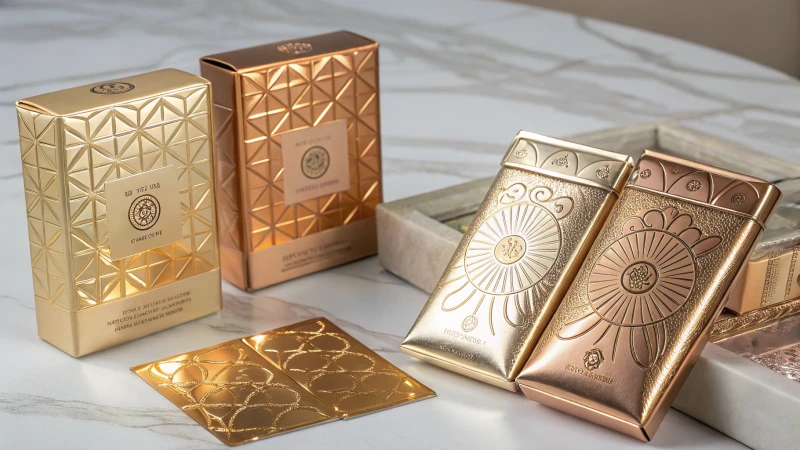
The Luxury Signal of Metallic Finishes
I remember the first time I held a product with a gold metallic finish; it felt like holding a piece of luxury. Metallic finishes scream sophistication and craftsmanship. Whether it’s gold conveying opulence or silver suggesting sleek modernity, these finishes are more than just a visual treat—they’re a brand statement12.
Materials and Techniques:
- Gold Finish: Think of it as wearing your best dress—it’s all about exclusivity.
- Silver Finish: The embodiment of modern chic.
- Rose Gold: A beautiful blend of elegance and modern vibes.
Each choice is like picking the perfect accessory that aligns seamlessly with your brand’s story.
Production Challenges and Innovations
Behind every dazzling metallic finish lies a tale of production challenges13. I’ve seen firsthand the complexities they introduce—from costs to manufacturing hurdles. But with challenges come innovations! Techniques like 3D printing now offer precise control over textures, reducing defects and boosting quality. It’s like finding that perfect recipe after several trials.
| Process | Advantage |
|---|---|
| 3D Printing | Precision control |
| Injection Molding | Cost efficiency |
Environmental Considerations
Sustainability is more than a trend—it’s our responsibility. I’ve noticed that metallic finishes now tell stories of eco-consciousness, especially with recyclable materials like aluminum. Choosing green manufacturing practices14 not only appeals to eco-aware consumers but also strengthens our brand’s ethical stance.
Creating a Visual Story
There’s an art to using metallic finishes to narrate a brand’s journey. Collaborating with designers to craft bespoke finishes can stir emotional connections. I recall a limited-edition design15 we once launched—it turned packaging into a collector’s item, boosting both engagement and loyalty.
Example Collaboration:
- Imagine working with local artisans to create unique metal textures that embody your brand’s spirit.
By transforming packaging into a storytelling tool, we don’t just offer protection—we create unforgettable market presence.
Gold finishes always signal luxury and exclusivity.True
Gold is universally associated with opulence, enhancing brand perception.
3D printing increases defects in metallic finishes.False
3D printing reduces defects by offering precise control over textures.
Conclusion
Metallic finishes on droppers enhance luxury branding by signaling quality and exclusivity, while also presenting production complexities and sustainability challenges that brands must navigate.
-
Discover how metallic packaging enhances brand perception through luxury appeal and differentiation. ↩
-
Learn how unique packaging designs can communicate a brand’s narrative effectively. ↩
-
Explore the environmental advantages of recyclable metallic packaging materials. ↩
-
Uncover new manufacturing methods that improve efficiency in metallic packaging production. ↩
-
Anodizing enhances metal surfaces, providing durability and resistance to corrosion, crucial for maintaining product quality. ↩
-
PVD coating offers a superior finish with minimal waste, ideal for achieving premium metallic aesthetics. ↩
-
Ensuring high-quality finishes is critical to avoid defects like peeling, crucial for maintaining brand reputation. ↩
-
Explore how durable materials in manufacturing contribute to sustainability by reducing waste through extended product lifespans. ↩
-
Understand the significant energy savings achieved through metal recycling, highlighting its role in sustainable development. ↩
-
Discover innovative eco-friendly surface treatment options that minimize environmental impact while maintaining desired finishes. ↩
-
Learn about market trends driven by eco-conscious consumers and how they influence brand strategies. ↩
-
Explore how metallic finishes are linked to luxury branding and their impact on consumer perception. ↩
-
Learn about the production challenges of metallic finishes and innovative solutions for better quality control. ↩
-
Discover how adopting green manufacturing practices in metallic packaging can benefit brands. ↩
-
See examples of limited edition metallic packaging designs that enhance brand storytelling. ↩



